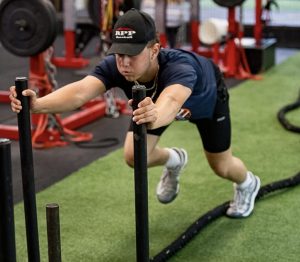
“Strength gains are attained in the weight room… Not inside the nets or on the baseball field.”
Why is Strength Important?
Pitching and hitting mechanics are really about how you “shift gears” to maximize your top-end speed. But how powerful each gear is will decide how fast we can go in each of those gears in order to unfold the delivery and create a consistent, more powerful mechanics with a higher velocity ceiling.
If appropriate exercise guidelines are followed when participating in a youth baseball strength training program, the risks associated with it are not greater than any other activity in which children and adolescents regularly participate in. The key is to find a qualified facility, age-specific instruction and a safe training environment in order to reduce the risk of injury.
RPP’s strength training programs for are directly tied to helping improve mechanics and strengthening those gears by increasing mobility, strength and overall athleticism.
Strength Training Programs
Our world-class strength programs for baseball players are 100% designed around the player and are highly specialized and customized for the sport. They are the cornerstone of our programming and designed to go hand-in-hand with our pitching and hitting development programs. Below are a few highlights of our program.
Assessment / Mobility
Every training program performed here at RPP revolves around our assessment. A movement assessment can tell us many things about an athlete’s “strategy” or in other words how they get from point A to point B. Correcting an athlete’s strategy is also paramount in helping reduce the risk of injury on the field and in the weight room.
We provide all our athletes who receive an assessment, and are training with us, their own personal mobility program. The mobility program is provided complete with videos that can be followed and performed at home or on the field. This allows our pitching and hitting coaches the ability to get our athletes into more efficient positions on the mound or behind the plate that were previously un-attainable.
Velocity-Based Training (VBT)
VBT is a training method in which bar speed is monitored to help an athlete train in a specific “zone” to help create a specific training adaptation (more on this later). By getting external feedback on the speed of the lift, athletes can get immediate feedback on power and intent which goes hand and hand with great performance on the mound and field. It also allows us to adjust the weight either up or down to match the strength zone we are chasing.
Proteus Motion
To be a more efficient baseball player, it’s important that you have both high amounts of force (power) and acceleration in your throw or in the box. For a pitcher, it can be a deal breaker in terms of college recruiting or ultimately being an MLB prospect. As far as hitters go, having a faster, more powerful swing allows the hitter more time to make better decisions at the plate.
And it’s not all about the lower half. Upper half power is what we see lacking in 75% of the athletes that come to us to train. That is why we have begun incorporating the Proteus Motion into our assessments. The Proteus measures and tracks data on power and acceleration, better known as “strength/speed” and “speed/strength”, two training adaptations that, up until now, have been hard to assess and train accurately in an athlete’s core and upper body.
World-Class Programming
Our programming for athletes 16+ is 100% individualized based off of our baseline mobility and strength testing. New programs are delivered every 4 weeks and reversed engineered in order to be assured that each athlete is ready for the season. Athletes under the age of 16 will train in groups with a baseball specific program , but programming will change monthly as well.
Getting a Head Start with LTAD
Strength is still the foundation of most athletic qualities; the best part is, it’s also the most trainable – especially with the younger age groups. Youth baseball strength training should be a part of every athlete’s development and progression.
As an adolescent athlete grows, his center of gravity moves further away from the ground and their core. This is why we see clumsiness in youth during their growth spurts both on and off the field. This is why a good dose of strength training can go a long way with respect to creating a better base of support. In turn, this can make young athletes better at coming out of low positions such as foot strike on the mound or heel strike behind the plate.
Ages 13-16 – In our long-term development plan, every young athlete must be able to hip hinge, squat, push, pull, carry, and perform single-leg movements in order to move on to more “advanced” movements and/or speed work. Just as important is the arm care that is incorporated into our strength programs as well.
Strength training for our novice athletes with little to no training experience will be performed in a group setting of no more than 8 people and 2-3 coaches. The programs will change every 4-6 weeks based on the season and will focus on:
-
-
-
- Upper / Lower Body Strength Training
- Tri-planar Core Development
- Velocity-Based Training (when applicable)
- Movement (eccentric, concentric power development)
- Energy System Work (specific to game-time performance and time of year)
-
-
Ages 16 and older – For older athletes, programming can be much more “individualized as training age increases. With the use velocity-based training (VBT) with our more experienced athletes we can better pinpoint the correct load for each athlete based off of day-to-day fatigue while reducing the risk of excessive loading. The weight room is monitored continuously by strength coaches to reduce the risk of injury due to poor form being used.
If appropriate exercise guidelines are followed when participating in a youth baseball strength training program, the risks associated with it are not greater than any other activity in which children and adolescents regularly participate in. The key is to find a qualified facility, age-specific instruction and a safe training environment in order to reduce the risk of injury.
